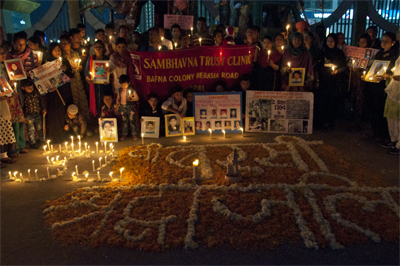
At the 32nd anniversary of the Bhopal Disaster, staff from the Sambhavna Trust Clinic held a candlelight vigil, in front of the “People’s Mall” in Bhopal, to honour the thousands who have perished as a result of the ongoing disaster and to highlight the fact that the contamination crisis continues to worsen. A message spelled out in flowers, in front of the assembled staff, simply said “32nd Anniversary Commiserations”.
Thirty-two years after the world’s worst chemical disaster struck Bhopal, the city’s residents continue to be exposed to chemical toxins through soil, groundwater and air. Studies by the Sambhavna Trust Clinic, which has been providing free medical care to 32,000 survivors, reveal that the contaminated area around the abandoned Union Carbide pesticide factory has increased by at least two square kilometres in the last four years.
The trust insists that, so long as thousands of tonnes of toxic waste remain buried in and around the factory, the contamination will continue to spread and find new victims. Five samples of groundwater were recently tested at the government Public Health Engineering Department’s laboratory and all of them were found to have prohibitively high chemical oxygen demand (COD) values. Samples tested by Sambhavna were also found to contain hazardous organochlorines.
The contaminants found in the water are known to cause cancers and birth defects, and damage the liver, kidneys, lungs and brain.
Priyank Sharma, said: “Sixteen studies from 1990 to 2012 by government and non-government agencies have shown that the ongoing contamination is a consequence of reckless dumping of poisonous waste by the factory management in and outside the factory.”
Sambhavna Trust physician, Dr Qaisar said: “Rehabilitation of the people living in that vicinity should be the priority. Secondly, a specific protocol needs to be assigned to gas-affected people.”
He also stressed on the need to relocate people from the area “they are as unsafe as they were 32 years back” and urged the government to act on the numerous studies carried out by NGOs which clearly demonstrate a worsening public health crisis as a result of this toxic groundwater.


